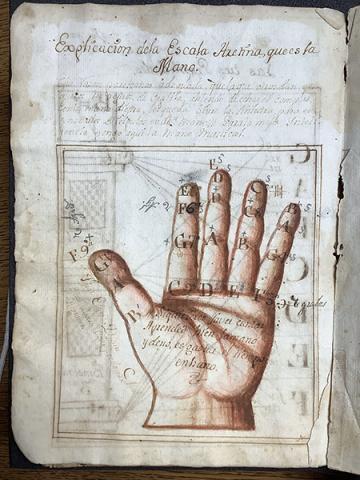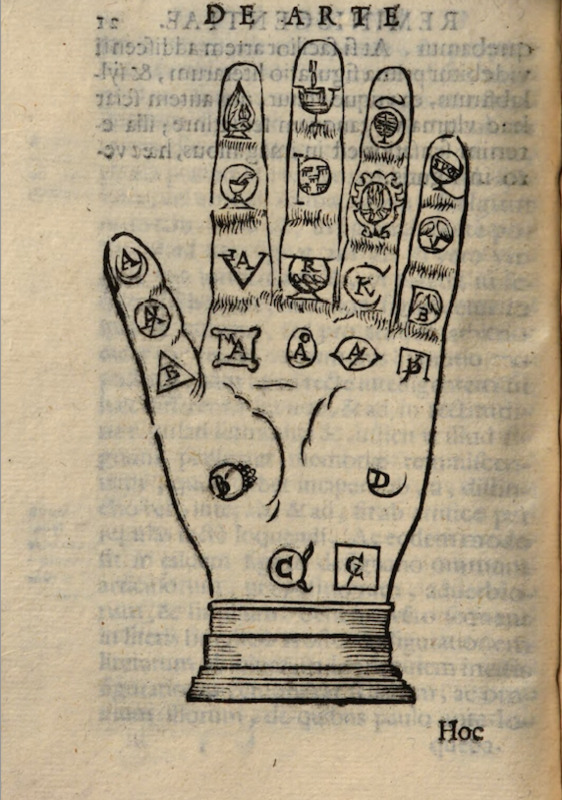
Exhibit curated by Joyce Zhao
Hands have captured our imaginations for centuries. Perhaps most famously, artists like Rodin, Picasso, and Michaelangelo have featured hands prominently in their work. However, hands also have played important roles in the history of memory, calculation, and cognition.
In his 2004 essay, Edwin Hutchins draws on Fauconnier and Turner’s cognitive framework of conceptual blending. During a conceptual blend, two input mental spaces are “blended” to yield a third space. That is, conceptual blending generates new knowledge, or what Fauconnier and Turner describe as “cognitive work” (2003). To arrive at this new knowledge, we must “run the blend”. In the language of diagrams, we reason with the diagram and its visuality to generate something new or learn something. As a simple example, a train time table diagram combines the geometric table structure with the understanding of time, and running this blend allows us to know what trains we must take.
To Hutchins, the richness of running the blend can be strengthened when one of our mental input spaces is instead material, such as a diagram or even a hand. He refers to these input spaces as material anchors. The image of an anchor explains why they are so effective. When we are able to visualize or hold a concept, it becomes more stable; it is “held in place” in our mind because we can visualize it. This allows us to reason more complexly and arrive at more elaborate conclusions. In this exhibit, I’ll briefly examine a few examples of how hands have been used as material anchors as diagrams, or how we might “run the hand”.
The Guidonian Hand
The Guidonian hand was a mnemonic device used in the Middle Ages as a musical symbol. It’s thought to be a product of Guido of Arezzo, a Benedictine monk. He is also credited with inventing the staff notation that we use today to visualize music. Each location on the hand represents a different note in a six-tone scale. The progression of the notes starts on the left hand thumb and moves around the hand in a spiral shape. It was thought that the Guidonian hand diagram could have been useful for pointing out notes during monastic chants, or just helping monks understand music theory and note relations better. You can find this manuscript in Georgetown’s Special Collections!
Running this hand generates a new musical notation that is universal and portable. In this case, the hand provides a material anchor for monks to map musical relations. Intervals between notes are not just up to memory and intuition, but are explicitly mapped. Pointing to different joints on the finger also creates the possibility of sequence, perhaps allowing monastic chants to be more systematic and accurate. The endless configurations of notes possible with the hand generates increases the complexity of musical understanding, with one hand being able to direct musical forms such as rounds and loops.
Japanese Hand Calculator
Now let’s consider how hands can be used for a different purpose: calculation. The Japanese Hand Calculator shown here is used by students to calculate the day of the week given any day of the year through a mapping of 12 months and the 7 days of the week. In this specific example, the diagram is configured for the year 2002. I will let Hutchins explain how the diagram is used:
The correspondences of day names and month names change frrom year to year. To determine the day of the week of an arbitrary date in 2002, say August 23, one simply looks at the hand – while imagining the month and day names – and finds the box containing the month name. The day name in that box is ‘‘Wednesday’’. This means that all of the Wednesdays in August of 2002 fall on dates that are 0 modulo 7. Thus, the 7th, the 14th, the 21st, and the 28th of August are Wednesdays. Imagine the 21st of August. It’s a trivial computation to determine that the 21st is a Wednesday (Hutchins, 2004, p. 1566).
Here, the hand is used to generate new information a bit more obviously. While the same calculation can be performed mathematically on paper, the conceptual mapping of months and day names onto the hand permits a stable and simpler understanding of more complex computation, perhaps leading to the diagram’s favorability with school children. By stability, I mean that we are able to reason with fixed concepts and objects, without being subject to the mind’s forgetfulness or abstractness.
The Art of Memory
Finally, the material anchor of a hand provides useful tools for memory. In a 17th-century treatise on the art of memory, Girolamo Marafioti, an Italian humanist, historian and priest presents diagrams of hands that map ninety-two geometrics symbols — twenty-three on the front and back of each hand. Only one of these hands is shown here, but you can flip through the primary source to find images of all the other symbols.
To “run this hand”, one would associate a piece of information to each symbol on the hand. Hutchins describes this process as the method of loci. This method allows for the memorization of long sequences of ideas by blending the shape of a motion with the set of symbolic landmarks. For example, if we can trace the sections of our hands, in this blended space, “the items to be remembered acquire the sequential relations that were created among the landmarks” (Hutchins, 2004, p. 1564). The act of tracing the hand, alongside its symbols, provides memory cues that aid our recall of ideas and objects. The customizability of the symbols, as they in themselves do not represent anything, allows for the method of loci to be applied in an endless number of ways.
Hands, as material anchors, allow us to distill some of the complexities of the world to our fingertips, quite literally. They are calculators, musical devices, and mnemonics. Our abilities to reason with logic and present new and creative ideas with hands not only contribute to their aesthetic but also cognitive value. Hands allow (most of) us to bring the power of diagrams and visual thinking around wherever we go.
References
Hutchins, E. (2005). Material anchors for conceptual blends. Journal of Pragmatics, 37(10), 1555–1577. https://doi.org/10.1016/j.pragma.2004.06.008
Fauconnier, G., & Turner, M. (2003). The way we think: Conceptual blending and the mind’s hidden complexities. Basic Books.


